Our roving reporter, Pam Holland, takes us with her to South Africa. This week, in Part I, we join in the joy of quilters all over the world. As we start this new year, you will be reminded to "Brighten the corner where you are."
Our roving reporter, Pam Holland, takes us with her to South Africa. This week, in Part I, we join in the joy of quilters all over the world. As we start this new year, you will be reminded to "Brighten the corner where you are."
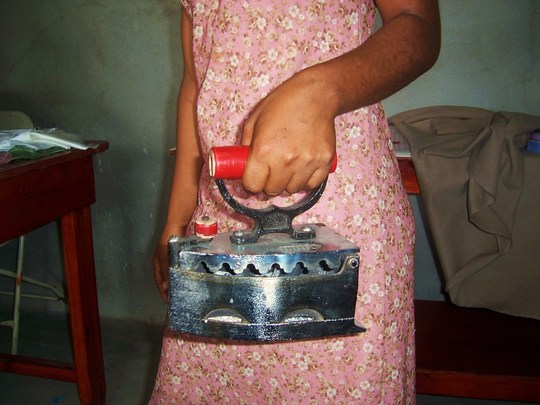
Quilting in Haiti
by Jo Van Loo
When was the last time you walked into your studio to work and had to remember to fire up the charcoal stove in order to have the iron ready to press fabric for your project? Many of us may remember our mother or grandmother working in this time consuming and dangerous fashion. But, most of us today have the luxury of electric irons, sewing machines and other handy tools to create our quilting projects.
While at the Houston Quilt Festival TQS met Jo Van Loo as she was preparing for a teaching trip to Haiti with Peacequilts, a development project that provides work with dignity to impoverished women. We asked her to share with you her journal of the trip and the women she met while in Haiti. Day One: Although I've traveled to many third world countries, arriving in Haiti yesterday was an experience unlike any other I've had. There was a crush of porters and beggars who swarmed about us the moment we stepped out of the airport terminal. Here in the poorest country in our hemisphere, it's abundantly clear that life is an achingly difficult struggle. After a hot, dusty, noisy 45-minute drive through the capitol of Port-au-Prince, our group of seven Americans arrived at a little oasis of green just outside the city in the town of Lilavois. This is the location of Artisanat Patchwork de Paix (Peacequilts Cooperative). It is situated within a school compound run by a teaching order of indigenous Haitian Sisters, the Daughters of Mary Queen Immaculate. They have nine other schools located throughout Haiti. Each location has a training school for young women, teaching them sewing and cooking skills in addition to academics. The Peacequilts Cooperative is a model program which will be replicated at the other schools, and provides an incentive for students to aspire to membership after graduation. Upon our arrival, the women of the cooperative greeted us enthusiastically, eage to show us what they had been working on. A welcome sign and streamers decorated the workspace, giving us a warm welcome. They soon began to pull out a colorful array of quilts they were in the process of completing, each one unique and beautifully decorated with Haitian imagery.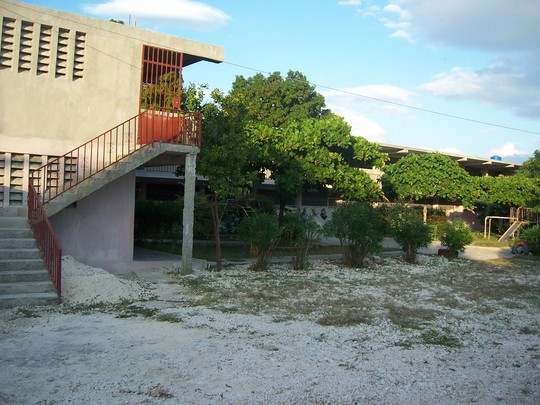
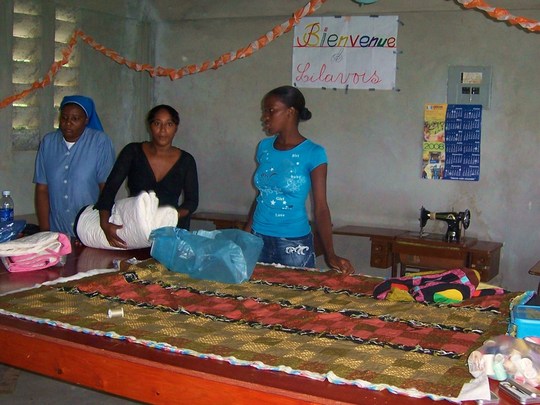
We will waste no time in getting started with the workshop first thing tomorrow morning. I'm really looking forward to it!
Day Two:
I'm here with the project's director, Jeanne Staples, and the quilting coordinator, Maureen Matthews McClintock. My role is to present a workshop teaching the fundamentals of crazy quilting, an approach which will allow them to utilize every scrap of fabric available. Fabric is scarce and expensive. Haitians wear their clothing until there's virtually nothing left, so all of the materials and most of their equipment must be brought from the United States (see before and after "stash" photos)

"Stash before group arrival"
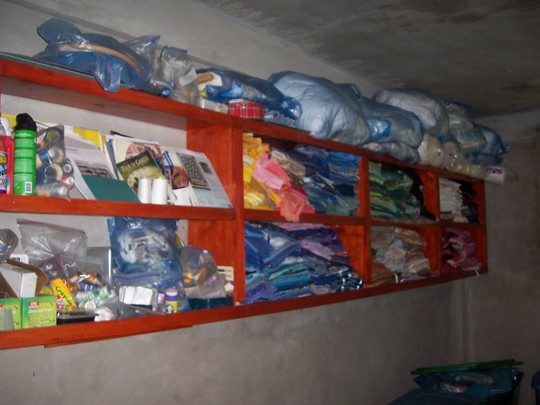
"Stash after group arrival"
Since there is no electricity, treadle machines and charcoal irons are used. The women arrive each day at 8 AM and work until about 1 PM. There is a very professional atmosphere with established procedures for sign-in, set-up, organization and clean-up. As the women began to work, I noticed that they chatted amiably, and didn't hesitate to help each other. Day Three: On the third day we were in Haiti, I taught the women how to make a crazy quilt block. We attached the pieces by hand on a foundation of muslin. The women selected their palette and learned quickly hot to create a crazy quilt block. They then very proudly showed off their handiwork. Sincerely, Jo Van Loo To learn more about the Peacequilt project and how you can help visit their website here. 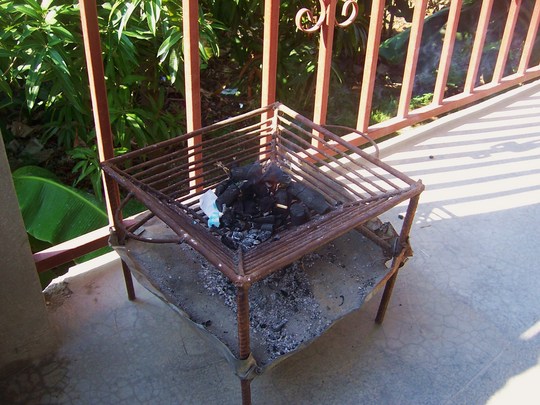
Charcoal used to heat the irons
"Crazy Patch" Workshop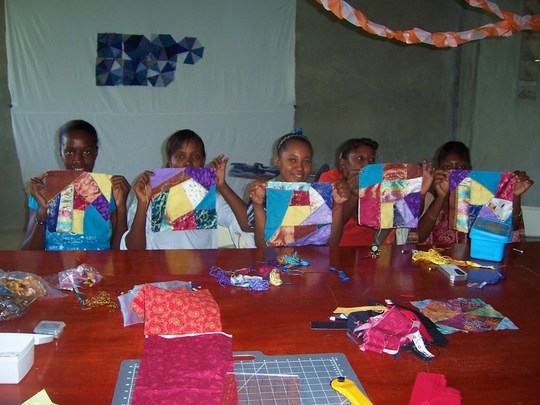
Showing off handiwork
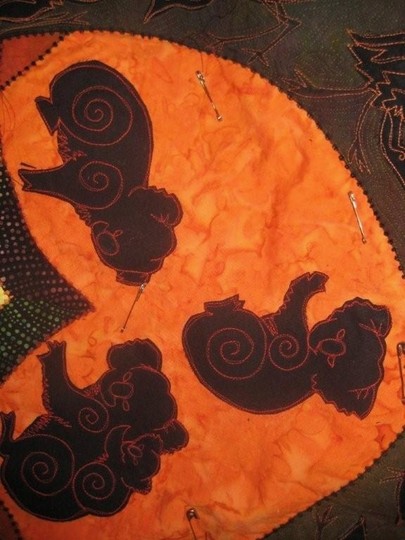
I have added the same embroidery stitch on to the snake as the edges of the original shapes, the dotted line stitch. I used a variegated thread that changed only every 12". It had colours grading from yellow to orange to red, hot pink and bright purple. Although I am a fan of bright colours, the bright purple and hot pink are not in keeping with the overall colour scheme...so a red fabric marker fixes that. Colour over the hot pink with red and it becomes a dark red, over the bright purple it becomes a dark plum/brown...much better. And if I slip whilst colouring in with the marker...it's ok coz I am working on a black background...all good. So I vary my variegated thread! The snake now has an extra two layers of batting underneath so she will trapunto quite well...fingers crossed.
Now...I thought it was all going too smoothly. Everything falling into place, colour and design all going well...until the koalas. I shall now admit having selected fabrics, traced and cut out 16 koalas, ironing on, and then stitching around in black...adding red...changing to green, trying yellow...now un-picking red, green, yellow...now un-picking purple/brown coloured koalas and going back to black. If I add that up, that's about 4 hours I am now reversing and un-sewing takes about five times as long...ahhhhh. But I will un-pick when I know it is worth it. Everything else is working so well I don't want to spoil it for the trouble of un-picking. Gives me an excuse to catch up on some DVD's for a while anyway. Now with koalas in place, black and stitched in red I am ready to sandwich up!
Talking of lunch...did you know koalas eat only one particular tree and spend most of their day eating and sleeping? The name koala in the aboriginal language means "that which does not drink" and the aboriginals did not hunt the koalas. Koalas get most of their moisture from the young leaves and don't often venture to the bush floor. It is said the koala, like the one asleep on the left is quite "stoned" from the eucalyptus oil in the gum tree leaves. That's why they are so laid back, casual, and sleepy. Koalas are in no way related to a bear which is often how they are referred. They are a marsupial with a pouch for the young ones to latch on to mums milk. When the koala is a toddler, mum carries it on her back. Mum has only one back so only one baby every second year is the norm. They are a wonderful part of what makes Australia so unique but unfortunately; our white influence in this country for over 200 years has meant drops in the koala population as they were killed for their fur. Now they have an eye disease making them blind and vulnerable to predators, so they it is quite rare to actually see them in the wild unless you know where to go looking. They are wonderfully soft cuddly creature, but there are very few opportunities in Australia to actually cuddle one...but when I did...I cried. It is very special indeed. They have huge claws for climbing so it can get dangerous and will scratch and claw if provoked. They really want to be left alone to chew, relax, and sleep it off man!
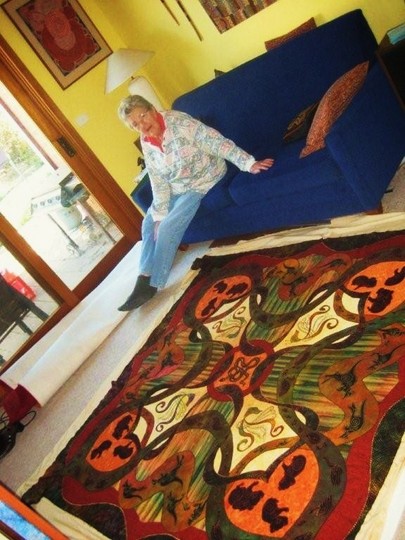
Photo by Helen Godden
Ok. I have sandwiched the quilt using basting spray and safety pins, so let's start stitching. That's my mum there...supervising. She loves this quilt, all her kinda colours. I am going to start in the middle and secure the snake, then work around the lyrebird areas, then secure some of the ribbons beginning with the green emu ribbon. It should trapunto up then (is trapunt the verb? It is Italian meaning to fatten...I have been trapunto-ing my body lately). Once some major ribbons are quilted in place, there should be very little movement across the quilt.
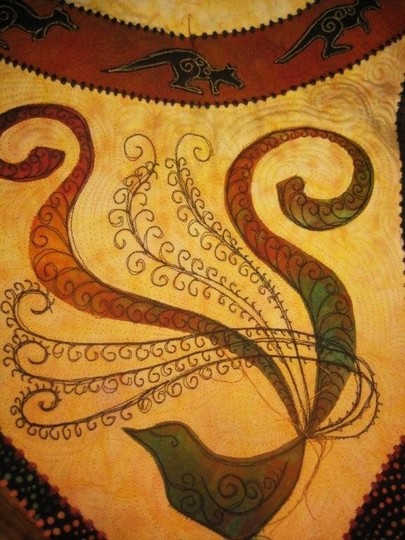
Photo by Helen Godden
I am going with a busy backing fabric and using matching bobbin thread with is not my norm. I usually opt for a plain back with strong contrasting bobbin thread, say purple or usually black, so the "drawing" I do with my quilting shows up on the back and is a fun extra feature. This also shows up any glitch or hick-up in tension or start/stop points. I have had some peer advice suggesting I don't use plain backs so judges cannot see any glitches...so I am conforming slightly and ouch...it hurts!
Did I mention the animals are all raw edge applique? You no doubt have worked that out anyway. I work almost 90% of my stitching in free motion. I really have to concentrate on how to operate the machine if I just want to do straight stitch...only happens for bindings really. When I work medium a size piece, I am on my Husqvarna VIKING, either my favorite Designer II or my new fabulous Sapphire 870...that's the one with the really wide throat section...10" which is 2'' bigger than most domestic machines. It's what we girls have always wanted, right!
Koalas will next have suggestions of gum tree trunk and lots of branches of gum leaves around them...added with black marker and detailed with green thread. That's the plan, so wait and see.
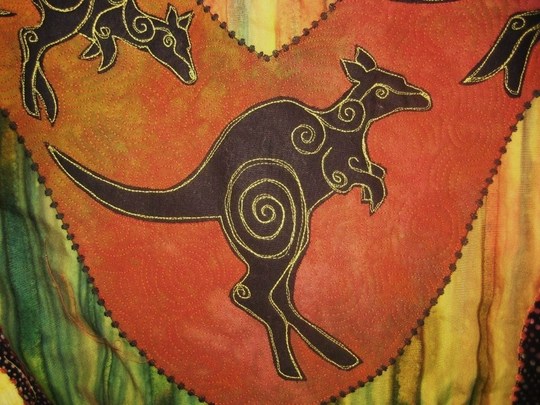
Photo by Helen Godden
I have completed all the quilting around the kangaroo background with a subtle tan colour. The quilting echoes the jump of the roos and has spiral circles amongst it which represent the aboriginal dreamtime patterns. It is interesting to note that in many ancient civilizations, the spiral pattern appears as a significant symbol often depicting the sun. For the Australian aboriginal, this symbol represents a meeting place or a waterhole but it is more of a cluster of concentric circles rather than a spiral. But a spiral is easier to quilt than individual circles. As I tell students, it's all about continuous line work.
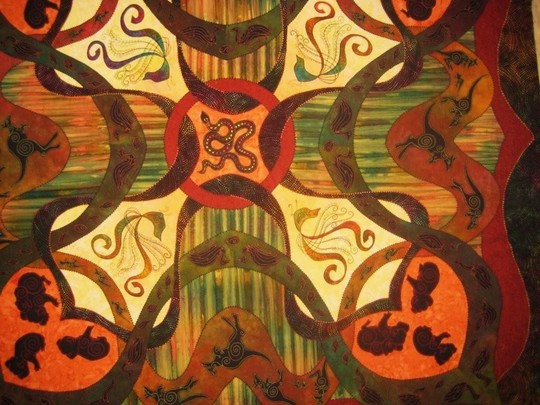
Photo by Helen Godden
On the home stretch now-as I am quilting, my mind is wandering off to the next potential quilt. This is a sign that I know this piece will work and I can see its fruition so I am dreaming and planning my next piece. I have to admit...I am thinking a lot about Houston too...with three prizes to accept, I will be there with flying colours! I have read some of your comments and hear you asking to see the finished quilt. I hope to have her complete before we fly out and if there is room in the luggage, I shall bring Australian Rhapsody to share. So more stitching and less typing.
Helen Godden
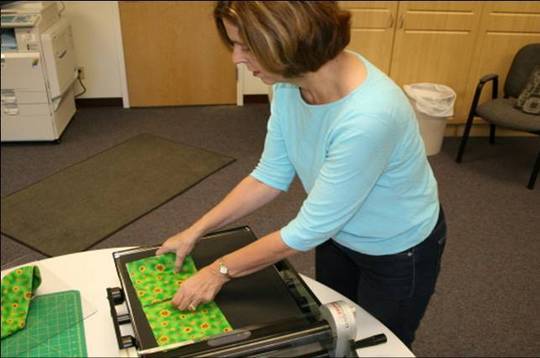
Mary Balagna is vice president of Project Linus, an organization that makes quilts and handmade blankets for children who are seriously ill, traumatized, or otherwise in need throughout the nation. In her work from Bloomington, Illinois, along with president Carol Babbitt, she serves more than 60,000 volunteers called “blanketeers” in about 400 local U.S. chapters. They make and collect more than 400,000 quilts and blankets each year. In addition, Mary oversees the Central Illinois chapter as chapter coordinator.
One of Mary’s responsibilities over the past decade has been to prepare materials for classes and booths at the annual Project Linus Expo held in Bloomington for chapter coordinators and their personal guests. That amounts to between 600 and 800 kits, each with a number of pre-cut quilt pieces. Some class kits include enough pieces for an entire quilt top so class time can be spent on sewing rather than cutting. That means Mary cuts as many as 20,000 pieces each year! It was getting painful. “We just couldn’t do it to her anymore,” Carol says.
That’s why the organization decided to start die cutting. They purchased an AccuQuilt™ Studio™ Fabric Cutter. It works by placing a die (with steel rule blade embedded in it) into a tray with fabric on top in layers, then a mat the die cuts into. You roll everything through the machine, and perfectly-cut shapes come out the other side. The shapes are easily plucked from the machine and inserted into bags. “If you are going to do anything on a large scale, there’s just not going to be a better way to do it,” Carol explains.
One of the benefits of having a cutter in the office is that Carol and Mary have easy access for year round project preparation. Carol loves using it to make sure pieces are perfect. “When I cut, I drive myself crazy. I measure, measure, measure, measure then cut. I can’t be accurate enough. Die cutting gives me a lot of peace of mind.”
Find out more about Project Linus at www.projectlinus.org. To see the AccuQuilt cutter, visit www.accuquilt.com.
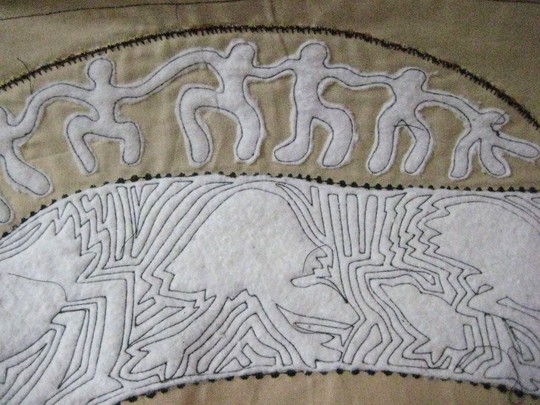
Around the last ribbon of my quilt, on the red, I have stitched my spirit people who appear regularly in my quilts as spirits of the land or reminders of people or civilizations past. They are much like a continuous chain of paper dolls like the ones we cut from paper as kids. Here I have stitched heavily around the spirit people images to make them raised.
Planning on some trapunto for the red spirit people ribbon and for the green emu ribbon so I added batting (wadding) under those areas. I stitched around my spirit people and then cut away the excess. The hope is that the little chain of people will stand up slightly proud. With the green emu ribbon, I quilted around every emu quite heavily filling in the area, and then trimmed back to the edge of the ribbon. My hope is that when it is sandwiched the emu ribbon will be raised compared to other areas.
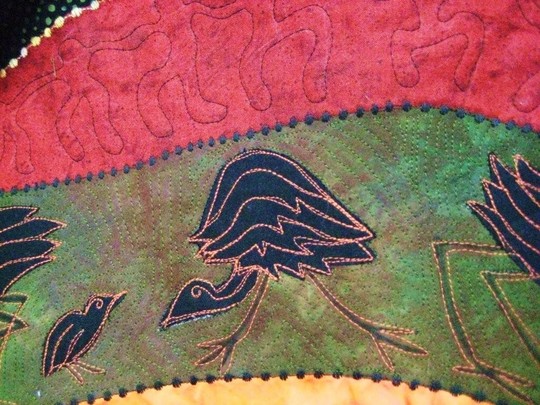
Photo by Helen Godden
Now the snake in the middle, while he was sleeping I stitched down the centre of his body in a lovely variegated thread but it had a hot pink in amongst the colour range so after it was stitched I used my red fabric marker and colour over the hot pink turning the stitches red. I also coloured over the purple to make it more aubergine (plum) in colour. Because the body of the snake is black, if I missed with the marker...it didn't matter, it didn't show up. I often work on black as I find it adds high contrast and a drama to the work. When I am teaching students I tell them that at the end of a quilt, instead of going over it with "a fine tooth comb" (as the saying goes) looking for stray threads or missed stitches, I go over my quilt with a black fabric marker. Any stitch in the wrong place on a black background can be made invisible with a black marker. Now that's our little secret. The snake has the same dot stitch running down his back gradually decreasing in size towards the tail.
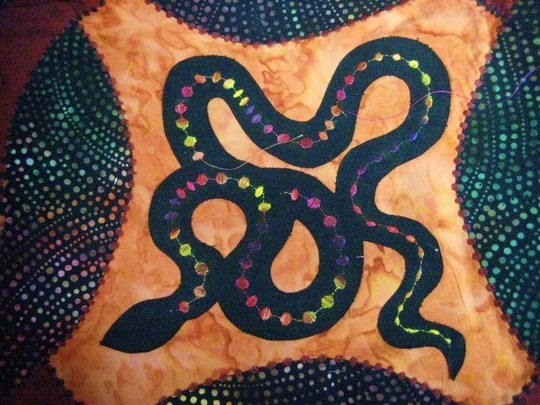
Photo by Helen Godden
Towards the middle are four Lyre birds, another of Australia's unusual creatures. The Lyre bird is a small bird, about the size of a skinny chicken, brown and dull in color but amazing range of vocals. The name comes from his lyre shaped tail. But also as he imitates all different birds, animal and noises from its environment to show off to his potential mates. In this manner, he lies about his identity! Such a bloke, showing off to lure a girl and not telling the truth about himself.
Back in June, I created a miniature 12 inch square for my state quilt guild show. This was a mini Ricky Rhapsody with the Lyre bird as the central feature. This piece was all applique, predominantly in reverse with the purple layer on top of the hand dyed gold/green. I worked zig zag satin stitch in free motion making it easier to get around the curves and give the stitch a look of calligraphy; changing from thick to thin back to thick as curves are followed. On the bird tails I worked on my sewing machine with one hand on the stitch width dial, increasing the width of the satin stitch as I went along, varying from 2.5mm/1/8" to 8mm/1/2" at its widest, in metallic gold. Looks good hey! It is a good practice to have a go at an idea in a smaller version before launching into a huge piece...good advice if you can be so disciplined.
Helen Godden
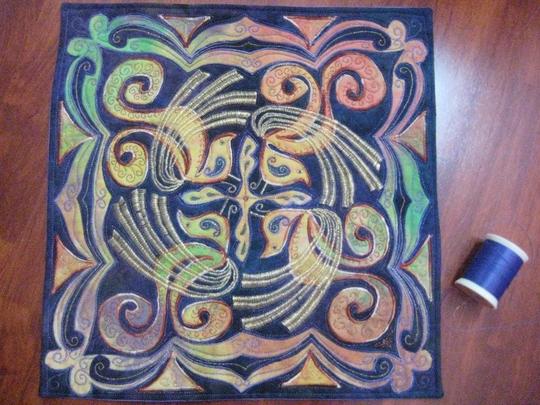
Photo by Helen Godden
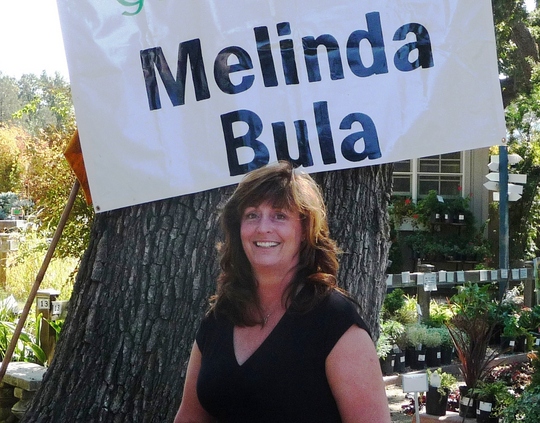
Melinda Bula
At 19 years old, Melinda was studying art in college and had her first job in a fabric store. It seemed a lot of customers were coming in for fabric for quilts. Why not make a quilt? Her great-grandmother was a quilter and she had been designing and working with fabric since she was 9, so it just fit. Melinda got a book (The Standard Book of Quilt Making and Collecting, by Marguerite Ickis 1949), cut out cardboard templates and made her first quilt.
A few years later she was a stewardess for Western Airlines. There was a lot of downtime so what do you do? You make another quilt. How about a double wedding ring? She didn’t know it was hard, she just loved the curves. Waiting between flights she continued to make quilts totally by hand. On the side Melinda started designing wallpaper. Soon she had a full business and was shipping designs across the country. One of her designs ended up in the model penthouse of the Trump Tower in New York.
Melinda and her husband Joe decided that she needed to give herself fully to art. She wasn’t sure what that exactly meant yet, but they decided to sell the business, move to a new area and give her full attention to art. One day she found herself inside because the dog wouldn’t walk with her in the 108 degree weather. She was new to town and didn’t know anyone yet, so she turned on the TV. There she saw this woman talking to quilters. Every morning from then on she watched Alex Anderson on “Simply Quilts” and quickly made 5 new quilts. Melinda found herself at a woman’s luncheon and told someone about her quilting. The person mentioned that she should get into a guild. She had no idea that there was such a thing as a quilt guild.
Melinda advises, “Take all the classes you can. Even the ones you don’t think you'll like. You never know what you will learn.” Melinda soon began incorporating her design background into the quilts and then brought her love of painting to the process using thread instead of paint. Besides beautiful quilts, Melinda also designs wearable art.
Melinda is now an award-winning quilter. Her sense of color and design has won her numerous ribbons. Most recently she won Best of Show, 2008 at Road to California for Monterey at Dusk. This quilt also won 3rd place at IQA Houston 2007. She received 2nd place at the same show with her flower quilt Romance.
Melinda’s first book came out in 2007 called Cutting Garden Quilts, published by Martingale Press.
Visit her website, www.melindabula.com
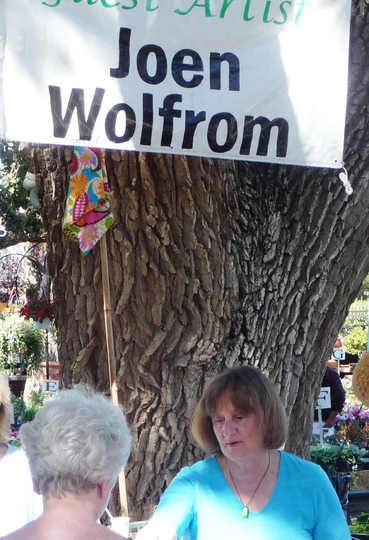
Joen Wolfrom
Joen is a great quilting teacher because she started as a teacher. Joen has been in the elementary classroom, worked with learning-disabled students and as a teacher/consultant for gifted students.
But how did quilting get into the picture? The same way as for many of you—she was invited to a class by a friend and couldn’t figure out how to get out of it politely. The class was once a week for 15 weeks. Each week was a different project. At the end of 15 weeks Joen had one pot holder to show for her efforts. She ended up taking the class 3 times.
Joen was contacted by an acquaintance to tutor her child. Later this person started a fabric store and asked Joen to teach quilting. Of course her answer was—no. At this time Joen was worried she would be just one step ahead of the students. They kept asking and Joen kept saying no. Then she thought of her Dad’s caution, “People often close the door to opportunity before they realize it has been opened for them”.
So she became a quilting teacher. She worked two days a week teaching 3, three hour classes a day. This lasted for 3 years. One day she received an invitation to teach in San Diego, California. Joen was happy in Washington but made the trip. Suddenly she was receiving invitations from all over. Well, why not? Quilting is a small interest and it will surely only last for about 1 year. This was 1984. Since then, Joen has taught all over the world.
Her interest in nature, color and photography has greatly influenced her quilting style. Her books include Color Play, The Visual Dance, Landscapes & Illusions, The Magical Effects of Color, Patchwork Persuasion, and great help for the mathematically challenged Make Any Block Any Size.
JWD Publishing is Joen’s new venture. She brings you great patterns from today’s top quilting artists. You can see Joen in action in Episode 103 “Visualizing Color” or check out her classes next week, October 8-11, at APQ in Des Moines, Iowa.
www.joenwolfrom.com http://www.jwdpublishing.com
"Whilst in La Veta in March 2008 with my 3 Sisters, in amongst our work and laughter creating our 2nd collaborative quilt, we had permission to dig through Ricky's scrap box and fossick (rummage) through the studio shelves amongst the odds and sods in case there was something we could use. We found glue, a sponge to paint with, scrap paper for sketching...a few bits that were handy. I dug a bit too deep and found a length of fabric that not only called to me...it yelled!
Originally a black and white commercial print, more black than white with a swirly fine dot pattern that had been over-dyed with tans, greens, golden yellows, burnt oranges and occasionally plums. I put on my best puppy eyes and asked Ricky if I could purchase the 2 yard piece from him.
"No, you can't." "But I need it...it's perfect...can we go halves on it?" "No we can't." Etc. Ricky then explained it was a gift from a friend and he could not give it away or sell it...it just was not right. I kinda begged him...but, but, but...I have plans for it...I explained how inspired I had been from being so up close and personal with his Rhapsody book and the potential it had for people to create such a variety of their own pieces. I then revealed all and started to describe my idea for an Australian Rhapsody quilt, using this particular over-dyed dot fabric to bring the Aboriginal dreamtime dot painting into the piece...he liked the sound of it and said..."you can have this fabric, but you gotta make the quilt and we gotta see it here first!"
As described in Ricky's book I started with my triangle. I worked the design over about fifteen times...should not have been hard I know, but I was planning my shapes and predicting the areas that the lines would create. Ricky's quilts usually have flowers, urns, flowing organic shapes, and other abstract eye pleasing shapes that are appliqued. To make this an Australian Rhapsody I intended to have all things Aussie in the applique and quilted areas...specifically kangaroos, emus, snakes, lizards, koalas, cockatoos, etc. So, with these animals and their shapes in mind, I designed the structure of my quilt with shaped areas that would lend themselves to these animals.

Original Seleton Sketch by Helen Godden
I had a stack of Ricky's beautiful hand dyed fabrics in all the earthy brown, tan, orange, gold, red, and dirty green that I love from my homeland. I also had a piece of beautifully striped Indonesian batik in olive, mustard, and burnt orange. I was ready to begin using my color palate and design.
Enlarging the design 300% using a photocopier made the areas big and workable for the animals. Looking through Ricky's book I could not see him using a striped fabric, but, this is Aussie, we don't follow convention. I rotated the striped fabric around so that the stripes radiates from the middle like the heat of our sun. The dotty over-dyed fabric runs throughout the design as a ribbon, giving a hint of Aboriginal design origins, adding to the overall Aussie flavor. All of the animals would be in black to stand out against the strong colored background and to give unity to the wide range of colors and textures I plan to use.
Ricky's book explains very well with photos and step by step how to piece the various shapes together for the base, curves and all. Well again, this Aussie does not follow rules. I decided to applique all the pieces together on a base fabric rather than piecing. Iron-on webbing manufacturers love me a I seemingly eat the stuff. So lots of iron-on webbing later, I have the pieces all ironed on the base, carefully overlapping and underlapping one shape to another, creating a 6-foot base.

Photo by Helen Godden
I played with the the fancy stitches on my Husqvarna Sapphire 870 and found a stitch that created a solid satin stitched dot joined by five straight stitches. I increased the size so the dots were about 1/4" in diameter every 1/2" along the stitch line. This gave a wonderful neat edge to the applique and enhanced the Aussie Aboriginal dot painting idea.
I then put on a favorite movie and started cutting out the animals. In total I cut twenty kangaroos in a variety of eight jumping positions. I then cut out twenty emus, standing, sitting, pecking, but not flying...second biggest bird in the world with the tinniest, quite embarrassing excuse for wings actually...as the song goes, "Emu can't fly but I'm telling you, Emu ran the pants off a Kangaroo". The design includes emu eggs and chicks which are actually born dark gray with white stripes that gradually then turn solid gray as they mature. Did you know it is the male emu that sits and tends to the eggs for months without leaving his nest? Woman's liberation at its finest.
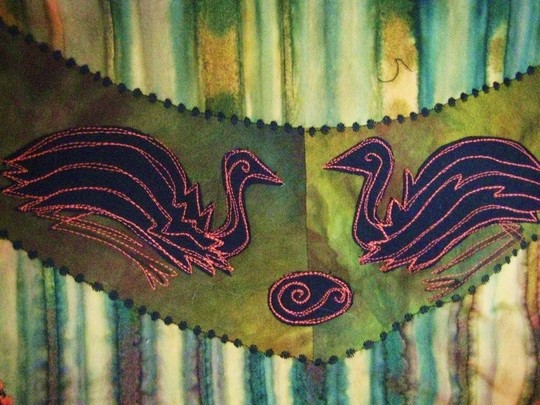
Photo by Helen Godden
The kangaroo and emu are the animals depicted on Australia's Coat of Arms. Do you know why these two animals represent Australia? Because neither of them can walk backwards due to their very long, big feet. They represent our forward moving culture...so the theory goes. I have very long, big feet...definitely Australian.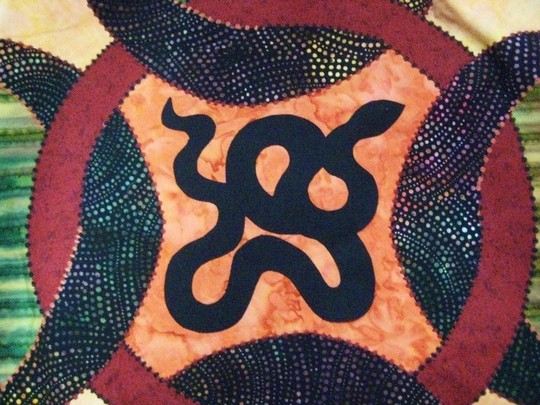
Photo by Helen Godden
My Aussie Rhap now has a snake in the middle. I like the snake in the middle...then I know exactly where it is and I can keep my eye on him. Not so keen on snakes but they are all a part of the big balance of nature I guess... still don't like them. In Aboriginal dreamtime legends, the Rainbow Serpent, a huge snake is said to have moved across the land and shaped the mountains, valleys, rivers, etc. I like having the snake there to acknowledge this ancient history of our land." Helen Godden
Stay tuned for more as Helen begins adding more stitching details to the quilt.
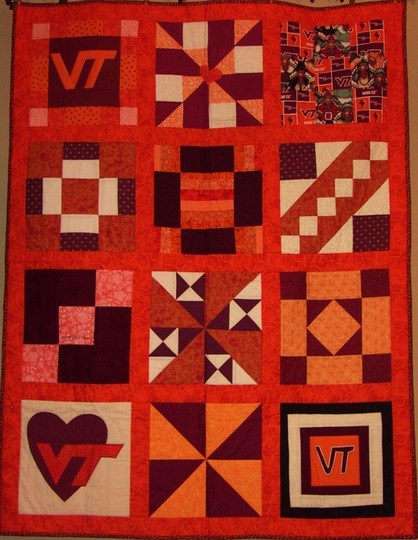
Virginia Tech Quilt for the Cueva Family
Over three hundred quilters from around the world generously gave of their time and materials by sewing blocks for the Virginia Tech Project founded by Agelina Kendra. Sixty five quilts have been completed and delivered to Blacksburg, VA where they will be distributed to family members and the University. The Roanoke Times tells the story of this incredible project that began with a simple e-mail conversation. To read the entire article click here. To see each of the family quilts being presented click here.
Pam Holland, the traveling quilter, has a new video. Watch closely to see if it's a picture of flowers or a picture of a quilt. It's not always easy to tell as Pam is a marvelous quilter. It's clear how nature influences her quilting. So take a stroll through Monet's Garden with Pam and The Quilt Show.
If you have not seen Pam's previous videos, be sure to scroll down the new table of contents on the Articles page to see her Mexico video and The Lights of Adelaide video.
Be sure to visit Pam's website. Her blog is great and she discusses quilts in progress and her travels. Click Here.